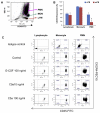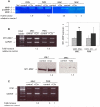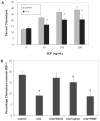Fifth complement cascade protein (C5) cleavage fragments disrupt the SDF-1/CXCR4 axis: further evidence that innate immunity orchestrates the mobilization of hematopoietic stem/progenitor cells
- PMID: 20153802
- PMCID: PMC2884222
- DOI: 10.1016/j.exphem.2010.02.002
Fifth complement cascade protein (C5) cleavage fragments disrupt the SDF-1/CXCR4 axis: further evidence that innate immunity orchestrates the mobilization of hematopoietic stem/progenitor cells
Abstract
Objective: Having previously demonstrated that the complement system modulates mobilization of hematopoietic stem/progenitor cells (HSPC) in mice, we investigated the involvement of C5 cleavage fragments (C5a/(desArg)C5a) in human HSPC mobilization.
Materials and methods: C5 cleavage fragments in the plasma were evaluated by enzyme-linked immunosorbent assay using human anti-(desArg)C5a antibody, and expression of the C5a/(desArg)C5a receptor (CD88) in hematopoietic cells by flow cytometry. We also examined the chemotactic responses of hematopoietic cells to C5 cleavage fragments and expression of stromal cell-derived factor-1 (SDF-1)-degrading proteases that perturb retention of HSPC in bone marrow, namely matrix metalloproteinase (MMP)-9, membrane type (MT) 1-MMP, and carboxypeptidase M.
Results: We found that plasma levels of (desArg)C5a are significantly higher in patients who are good mobilizers and correlate with CD34(+) cell and white blood cell counts in mobilized peripheral blood. C5 cleavage fragments did not chemoattract myeloid progenitors (colony-forming unit granulocyte-macrophage), but (desArg)C5a did strongly chemoattract mature nucleated cells. Consistently, CD88 was not detected on CD34(+) cells, but appeared on more mature myeloid precursors, monocytes, and granulocytes. Moreover, granulocyte colony-stimulating factor-mobilized peripheral blood mononuclear cells and polymorphonuclear cells had a significantly higher percentage of cells expressing CD88 than nonmobilized peripheral blood. Furthermore, C5a stimulation of granulocytes and monocytes decreased CXCR4 expression and chemotaxis toward an SDF-1 gradient and increased secretion of MMP-9 and expression of MT1-MMP and carboxypeptidase M.
Conclusion: C5 cleavage fragments not only induce a highly proteolytic microenvironment in human bone marrow, which perturbs retention through the CXCR4/SDF-1 axis, but also strongly chemoattracts granulocytes, promoting their egress into mobilized peripheral blood, which is crucial for subsequent mobilization of HSPC.
Figures








References
-
- Levesque JP, Winkler IG. Mobilization of hematopoietic stem cells: state of the art. Curr Opin Organ Transplant. 2008;13:53–58. - PubMed
-
- Lee H, Ratajczak MZ. Innate immunity: a key player in the mobilization of hematopoietic stem/progenitor cells. Arch Immunol Ther Exp. 2009;57:1–9. - PubMed
-
- Spiegel A, Kalinkovich A, Shivtiel S, Kollet O, Lapidot T. Stem cell regulation via dynamic interactions of the nervous and immune systems with the microenvironment. Cell Stem Cell. 2008;3:484–492. - PubMed
Publication types
MeSH terms
Substances
Grants and funding
LinkOut - more resources
Full Text Sources
Other Literature Sources
Medical
Miscellaneous

